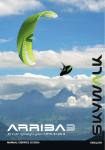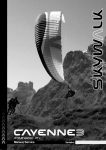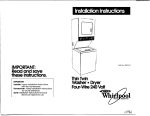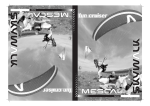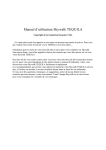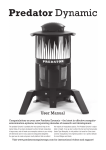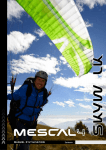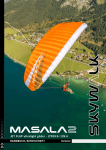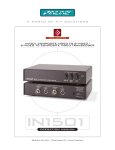Download Owner Manuall / Operating Instructions Seriennr:
Transcript
Owner Manuall / Operating Instructions Seriennr: Contents 1Congratulations 2Description, technical data, line system 3Acceleration system 4Harness 5Tandem Bar 6Flight techniques and characteristics 7Descent techniques 8Extreme flight manoeuvres 9Materials Maintenance 10 2-year-check / certification 11 Conclusion 12 Line plans, risers 13 Test protocols 14 02 Page 03 Page 04 Page 08 Page 08 Page 09 Page 10 Page 17 Page 20 Page 24 Page 25 Page 27 Page 28 Page 30 Page 32 1 Congratulations on the purchase of your new paraglider and thank you for your trust in skywalk. We have no doubts that you will enjoy every single minute of your flying with your skywalk JOIN’T To ensure that you feel at home on your new glider, we recommend you thoroughly read the owners manual/operating instructions. This way you will get to know your skywalk JOIN’T quickly and easily. The following instructions will help to maintain your skywalk JOIN’T in excellent condition, to use it safely and have fun with it for a very long time. Flying a tandem is double pleasure, because you can bring our sport closer to pedestrians. Flying a tandem also means taking over responsibility for someone’s life. Therefore flight planning and the flight itself should be conducted careful and considered. If you have any questions, remarks or suggestions for improvement, please don't hesitate to contact us by fax, e-mail or phone. The skywalk-team will be happy to help anytime. Your skywalk-team 03 2 Description We set ourselves a high target to reach, with the development of the skywalk JOIN’T. With a passionate work ethos and attention to detail we selected the best out of many prototypes to achieve the maximum in performance, safety, stability, handling and the pure fun of flying. During the testing phase we had the professional tandem pilot in mind – secure and controlled starts and landings were important defaults for the JOIN’T; Like the MESCAL and the TEQUILA we have integrated Jet Flaps in the wing, to improve passive safety of the JOIN’T and to enhance slow flight characteristics. This is especially noticeable during launches and landings, but even in turbulence the glider remains easy to handle and weak upwinds are transferred into altitude thanks to the slow flight characteristics. Comprehensive reinforcements and load equalizers are responsible for permanent profile quality and extremely durable cloth ensures optimal longevity of highly loaded areas. Reinforcing webbings relieve the lower sail and several additional flares evenly distribute forces across the profiles. The outside wing was designed to carry less load in order to achieve an even and predictable feel in turns. Large cross-ports in the ribs create an effective inflation of all cells without reducing the profiles shape. Velcro bands are attached to the outer wings to make it easier to empty the sand from the glider. Scope of delivery The JOIN’T comes with spreader, carabines as well as shackles for the reserve parachute. All fittings are stainless steel for best longevity. Additionally to the rucksack, every JOIN’T owner receives a Biplace Box. This serves to carry the glider when the rucksack is filled with harnesses and gear for the pilot and the passenger. 04 2 Technical Data Typ AR BI Number of Cells 44 44 Area [qm] 39,07 42,3 Wingspan [m] 13,78 14,34 Aspect ratio 4,86 4,86 Area projected [qm] 34,41 37,26 Wingspan projected [qm] 11,22 11,68 Aspect ratio projected 3,66 3,66 Line length [cm] 797 830 Line diameter [mm] 1,2/1,5/2,2 1,2/1,5/2,2 Cord max. [cm] 351 366 Cord min. [cm] 73 76 Canopy weight [kg] 9,6 10,4 Cert. Take-off-weight* [kg] 115 - 190 140 - 230 * Pilot + 17 kg equipment At the time of delivery, this paraglider corresponds to all the regulations of the German Paragliding and Delta Association (DHV) or the AFNOR (SHV and Aerotest). Further details of the construction and the measurements are described in the DHV-Luftsportgerätekennblatt, which is part of this manual. The measurements of the line elements are listed in the Luftsportgerätekennblatt or in the line plans. They are measured with 5 kg weight. The DHV measures from the line carabiner to the CAUTION THE TYPE SHIELD IS PRINTED ONTO THE INSIDE OF THE STABILO. THE DHV CERTIFICATION STICKER CAN BE FOUND IN A POCKET ON THE MIDDLE CELL. DATE AND NAME OF THE PILOT OF THE FIRST FLIGHT HAVE TO BE ENTERED. THE DHV CERTIFICATION STICKER HAS TO BE FIXED TO THE PARAGLIDER! 05 2 Line System The lay-out of the suspension points was made for optimal distribution of load and long life span. With all considerations and calculations however, our focus always was on safety. The mix of materials used on the lines of the JOIN´T is and ideal combination of durability, little stretch and low drag. The main lines of the JOIN´T are made of high-strength Tecnora with polyester sheathing. Each of these main lines can endure more than 300kg. But also New Dyneema is used with the JOIN´T because of its excellent resistance to aging. Also after years of intensive use, a reassuring amount of reserve safety remains in all parts of the JOIN’T. The skywalk JOINT has 4 A-, 4 B-, 4 C- as well as 3 D-main lines and 1 stabiliser line. With the lines one differs between toplines (near the canopy), intermediate-lines (assembling 2 or 3 toplines) and mainlines. These main lines assemble 2 to 4 intermediate-lines and lead to the quick links at riser (triangle line lock which connects the lines to the riser) The stabiliser lines connect to the top stabiliser lines with the carabiner. The brake lines are none carrying and lead from the back of the canopy (=trailing edge) over the main brake line through the pulley on the D-riser to the brake handle. There is a mark on the main brake line indicating the position of the handle attachment. This adjustment must not be altered in order to provide enough brake travel for landing and in extreme flight situations yet enough slack not to continuously brake the glider in normal flight. The A-lines, the stabiliser lines and the A-riser are coloured red for better discrimination. The B-lines, the main brake lines and the brake toplines are yellow and all other lines blue. The line maillons are triangular and have a rubber grommet to prevent the looped lines from slipping. 06 The skywalk JOIN´T uses 5 risers on each side. The two inner A-main lines are attached to the front A-riser, the outer A-main line attaches to the second A-riser. The B-lines and the stabiliser are attached to the B-riser. Excepted is the outer B-main, which leads to the C-riser. The C-main lines lead to the C-riser. Excepted is the outer C-main, which leads to the D-riser. The D-main lines lead to the D-riser. Please see riser drawing on page 30. IMPORTANT SAFETY WARNING Flying a paraglider requires maximum caution at all times. Be aware that flying your paraglider is at your own risk. As a pilot you have to guarantee the flying capability of your paraglider before every single flight. Don't use your skywalk JOIN’T: Outside the certified take-off weight With any engine, except if you have a license from the BHPA / USHPGA In rainy, snowy and extremely turbulent weather conditions or high winds In fog or clouds With insufficient experience or training Every tandem-pilot is responsible not just for his own security but also for his passenger and should take care that his Aircraft (paraglider) has been checked and serviced for its airworthiness before every flight. You can only fly your skywalk JOIN’T with a valid flying license and in accordance with local rules and regulations. During its production your skywalk JOIN´T has passed thorough quality control checks. More spot checks were performed before its despatch. 07 3 Acceleration System The JOIN´T is equipped with trimmers. These trimmers extend the rear risers and therefore accelerate the glider with a few km/h. In addition the trimmers can be used at starting in zero wind conditions. Opened half the glider rises even quicker. CAUTION THE DHV RATING OF SOME GLIDER SIZES CAN CHANGE DURING THE USE OF THE ACCELERATION SYSTEM IN FLIGHT. TO DETERMINE WHICH SIZES ARE AFFECTED PLEASE CHECK THE TYPE SHEET. One sided opening of the trimmers is to be avoided because arising asymmetry may influence flying behaviour negatively. Illustrations of the accelerated risers on page 30. 4 Harness When flying with passengers a tandem harness should be used at all times. Be aware that relative brake travel changes with height of the suspension. CAUTION Many harnesses are not suitable at all for tandem flying. Big airbags can obstruct the pilot and cause danger. In case of doubt, please consult an experienced tandem flight instructor 08 5 Tandem Bar The tandem bar is part of the glider system. All connecting elements must have a load limit of at least 9g of the maximum take of weight. (f.e. carabines) attachment point maincarabiner (steelcarabiner) attachment point rescue system (deltacarabiner) velcro fixing for rescue connection line loop in heavy passengers loop of rescue system pilots loop in loop in light passengers passangers attachment point depends also om pilots weight (light/heavy). 09 6 Flight Techniques and Characteristics PRE-FLIGHT CHECK AND MAINTENANCE It is important to check all paragliding equipment thoroughly before every flight, to see if it has any defects. Also check the paraglider after long flights and after long storage. Check thoroughly: All seams of the harness, of the risers and the of the reserve bridle. That all connecting parts, maillons and carabines are closed The brake-line knots on both sides and follow the brake-line to the top All the other lines from riser to canopy All the line attachment points at the canopy If the top or bottom of the wing are damaged or perished The ribs and cross ports from inside. DO NOT START IF YOU DETECT ANY DEFECTS, EVEN IF THEY ARE MINOR! If you find any damage or excessive wear and tear please get in touch with your flying school or skywalk. Laying out the glider If you use your paraglider for the first time we recommend that you practise some inflations and try some simple flights at a training site. This way you are able to get used to your skywalk JOIN’T. Lay out the canopy so that the leading edge is slightly arched. The middle of the canopy should form the deepest point of the paraglider. This way the A-lines are tensioned first in the middle whilst inflating. The paraglider inflates evenly which ensures a stable and straight take off. Separate A, B, C, D-lines and risers and put in order. Make sure that the brake lines run freely through the pulleys to the trailing edge of the paraglider. All lines have to run freely without any knots or twists from the risers to the canopy. During flight, tied or crossed over lines can often not be released or untangled! 10 The brake-lines are lying directly on the ground, so please pay attention that they can't ensnarl during launch. There shouldn’t be any lines beneath the canopy during take-off. Line-overs can have fatal consequences! TAKE-OFF The skywalk JOIN’T is very easy to launch.Hold the two A-risers and the brake handles in your hands. For a better identification, the A-lines and covers at the A-risers are coloured red. The brake lines are coloured yellow and the brake handles are black. Hold your arms slightly sideways and backwards like an extension of the A-risers. Before launching check the laid out glider. Further check the wind direction and the airspace! Pull rapidly and the canopy of the skywalk JOIN’T will launch and rise above your head. The canopy will inflate fast and reliable. Keep the paraglider straight above your head and run forward. Slow down a little as soon as the upward pull decreases. You can open any collapsed cells by pumping the affected side. Changes of directions that are necessary can be carried out now. Look and feel that the wing is properly inflated. Don't make your final decision to accelerate or to take-off until you are absolutely sure that the wing is properly and evenly inflated. Otherwise, stop the take-off produce immediately! During reverse launches and in strong winds, it is possible that the paraglider surges forward and inflates faster than intended. You can counteract this by running towards the glider. If you reverse launch it is advisable to only use the inside A-risers. This way the paraglider inflates a little slower and in strong winds you don't have to deal with the full pressure at once. With a tandem paraglider starts with to strong wind should be omitted out of consideration for the passenger. 11 The JOIN´T is equipped with the trend-setting Jet-Flap system, just like the MESCAL and the TEQUILA. Air is conducted from the bottom sail (pressure area) to the top sail (low-pressure area) and is blown out there with higher speed. The connection is established through jet shaped channels, which are located in the rear section of the wing. When increasing the angle-of-attack the danger of airflow interruption and subsequent stalling is minimized. Results: the constant airflow delays the stall even at great angles-of-attack, the flyable minimum speed is lowered and the pilot has a higher incidence range. This is of great importance, especially during starting and landing. Of course, the Jet-Flaps are no reason for uncontrolled braking, but the slow flight characteristics of the JOIN’T profit immensely. You don't need any special knowledge to have control of the flap system, the use of a Jet-Flap paraglider is the same as a conventional glider. 12 TURNING The skywalk JOIN´T is very manoeuvrable and reacts to steering inputs directly and without delays. During turning you can control the speed, the curve radius and banking by additional use of the outer brake. Counter braking or releasing the brake lines can change these parameters most effectively. Tight curves and/or wing overs are absolutely inappropriate for biplace flying! CAUTION PULLING THE BRAKE LINES TOO FAR AND TOO FAST CAN CAUSE A FULL STALL! You will recognise a flat spin through high steering pressure and a slight backwards folding of the outer wing section. If this happens you have to release the inside brake immediately. Emergency Steering In case one or both brake lines break you are able to steer and land the skywalk JOIN’T with the aid of the D-risers. Active Flying Active flying means flying in harmony with your paraglider. Anticipate the behaviour of your skywalk JOIN’T in flight, especially in turbulent and thermal conditions and react accordingly. In calm air necessary corrections will be minimal, but turbulence demands permanent attention and the use of brakes and weight shifting with the harness. Good pilots have instinctive reactions. It is important that you always have direct contact to the canopy by slight pressure on the brakes in order to feel the stored energy of the glider. This way you will recognise a loss of pressure in your canopy and subsequent collapse early and are able to react in time. Even if the pilot doesn't react, the skywalk JOIN’T will not collapse immediately. However, with Active Flying you can increase safety. 13 EXAMPLES When flying into strong thermals, you have to release the brakes. When flying into falling air stream, pull the brakes. This way you can avoid extensive changes of the angle of attack. In turbulent air, you feel the release in pressure on parts of the glider through the feedback from your brakes. You can balance this by quickly pulling the brake a little more until the pressure returns. Always apply brakes softly and progressively. Don't slow down your glider too fast as this can increase the danger of stalling! By active flying you can avoid almost all deformations of the glider in advance. Accelerated flying We remind you to fly only under wind conditions that allow for normal flight with the glider in untrimmed position. To accelerate open both trimmers successively. After reaching the desired speed, check that both trimmers are opened evenly. On activating the trimmers, pitch angle changes only slightly, because the rear risers are extended. This means that the JOIN’T is also very resistant to collapses with opened trimmers. Nevertheless trimmers should be closed in strong turbulences, but certainly under turbulent conditions on final for landing. Avoid flying with too short brake lines, otherwise the speed potential cannot be called upon. Accelerated collapses tend to be more impulsive and require increased readiness to react. NEVER LET GO OF THE BRAKE HANDLES! 14 LANDING The skywalk JOIN’T can be landed easily. Make a long!final against the wind and let the glider glide at full speed. The passenger should have been instructed beforehand, to prevent the landing can be performed without stress. At about 1m above the ground you increase the angle of attack by increasing the pressure on the brakes and hold the glider. After reaching minimum speed completely flare out the glider by applying full brake. In strong head winds, slow down carefully. When you have reached the ground safely, stall the glider warily. Especially when flying tandem a decent landing circuit must be performed. Oscillating and curve changes should not occur, otherwise the landing organisation was bad. The obviously greater weight of passenger and pilot and the longer lines have to be considered. This requires exercise and concentration. Occasional tandem flight should only be conducted in favourable conditions. WINDENSCHLEPP The skywalk JOIN´T is suitable for towing. Make sure you climb from the ground at a flat angle. The pilot must have a valid towing license. The used tow winch has to be authorised. The winch operator must have a towing license, which includes paragliding. When towing always steer sensitively, do not brake too much because the glider already flies at an increased angle of attack. In calm conditions the trimmers may be opened to achieve flatter climbing. MOTORFLUG You can inform yourself about the current status of certification of motorised flight at your dealer, national distributor or directly through us. We will certainly authorise the JOIN’T for paramotoring. At this time we don't have a license. (January 2005) 15 Carefully packing your paraglider will increase the longevity of your glider. Empty the glider from all debris such as leaves, twigs, grass, sand etc. Sort out your lines and spread them evenly on the glider. Make sure the glider is dry when storing it for a longer period of time. Fold the glider starting in the middle and working your way to the outside always folding 2 cells, so that the leading edge is folded cleanly. This folding method is best done together with a friend, but you should be able to do the same on your own after some practice. Fold the cells, starting from the second cell from the middle, so that the reinforced edges of the cell openings are on top of each other. Do the same at the lower long-edge of the glider. Then press the air out of the folded glider starting at the bottom and working your way to the top Fold the whole row once toward the middle. Do exactly the same on the other side. Then fold one half onto the other half and make sure the leading edge is folded cleanly. Start wrapping up the glider from its lower end. The wraps should be approx. 1ft. wide. The leading edge can be folded inwards once, but is not necessary. The left over air should be pressed out of the glider and not through the material (this can increase the porosity of your glider) Now attach the compression band around the packed wing, at right angles to the cell openings, then slide the glider into the light nylon bag. This helps to protect the cloth from being damaged by sharp edges or zippers from your harness. Open the rucksack and place your glider on the inside edge. The soft wing on your back will make transportation much more comfortable. Place the harness with the seat board facing up on top of your glider and close the zippers. Put the rest of your equipment (helmet, overall, instruments etc.) under the hood of your Packsack. The unique Biplace Box which comes with every JOIN’T allows for separate stowage of the glider. Both harnesses of pilot and passenger, as well as the complete equipment may be carried in the rucksack and the glider in the Box. 16 7 Descent Techniques The JOIN’T MANUAL is not a textbook for learning how to paraglide. According to the local rules and regulations, instruction and training must be carried out in licensed schools. The following information enables you to get the most out of your skywalk JOIN’T. SPIRAL DIVE You can initiate the spiral dive by carefully increasing the pull on one of the brakes and simultaneously shifting your weight to the inside of the turn. If the glider doesn't bank up and the sink rate doesn't increase, then try again. Don't just apply more and more brake without sensitivity. The skywalk JOIN’T enters the spiral dive with a high bank angle and makes a fast steep turn. You control the banking and sink rate by controlled pull or release of the inside brake line. Light outside brake can counteract the collapse of the inside wing section during a steep spiral dive. The spiral dive is the fastest way to lose altitude. CAUTION THE HIGH SINK RATE CAUSES HIGH PHYSICAL STRAIN DUE TO THE INCREASING CENTRIFUGAL FORCES AND MAY CAUSE BLACKOUTS! - Above all, please think of the passenger - Tensing the stomach muscles during the spiral dive can be helpful. At the first signs of dizziness or feeling faint exit the spiral dive immediately. Because of the extreme loss of altitude during a spiral dive always ensure you have enough height above ground. To avoid a strong surge when exiting the spiral dive, you have to release the inside brake while applying the outer brake slightly. The skywalk JOIN’T has no tendency for locking into a spiral dive. In case it keeps on turning under unfavourable circumstances (e.g. unintended asymmetry of the cross brace harness) you will have to actively finish the spiral dive. In this case shift your weight to the outside of the turn and simultaneously apply more outside brake. Applying both brakes will also take the paraglider out of the spiral dive but the glider can front tuck and you should dampen the exit with the brakes. Remember: Compared to regular flight manoeuvres the steering forces in a spiral dive are a lot higher! 17 Big Ears In contrast to the spiral dive and B-line stall, Big Ears result in an increase of forward speed in relation to the gliders sink rate. Big Ears is used to avoid or exit dangerous areas in a horizontal direction B-Line Stall Because of the double B-suspension, performance of a B-line stall limited. The additional suspension improves the true profile as well as the longevity of your glider. For rapid descents you should choose between spiralling and making ears, depending on the situation. 18 BEISPIELE In strong winds or below a thundercloud at low altitude it is possible that neither B-line stall or spiral dive will help. Big Ears are the easy way out. If the pilot is stuck in strong lift and needs to look for sink it is advisable to exit the lift band with the use of Big Ears.. In order to fold the wing tips you have to pull both outer A-risers simultaneously. This will cause both wing tips to fold inwards and the skywalk JOIN’T will enter a stable forward flight. The brake handles remain in your hands together with the outer A-risers. Braking and weight shift enables you to steer your paraglider. In order to increase the sink and forward speed you can optimise this manoeuvre by using the acceleration-system. The risk of canopy destabilisation in turbulent air is clearly reduced when using Big Ears. To exit Big Ears release the A-lines. The canopy will unfold automatically. You may brake a little to support the unfolding. It is advisable to pump out one side at a time to reduce the risk of detaching airflow. ALL DESCENT TECHNIQUES SHOULD BE TRAINED IN CALM AIR AND WITH SUFFICIENT ALTITUDE BEFORE USING THEM IN EMERGENCY SITUATIONS AND IN TURBULENT AIR. Any extreme flight manoeuvre and descent technique demands: Training, either with an instructor in a paragliding school or during a security training course. Double-checking that before entering a manoeuvre you have sufficient altitude and clear air space below. Permanent visual contact with the canopy. 19 8 Extreme Flight Manoeuvres ASYMMETRIC TUCK In strong turbulence, the canopy may collapse. The skywalk JOIN’T will re-open automatically even after bigger collapses within a turn of 180. The turning towards the collapsed wing section can be minimised by braking on the remaining open side of the canopy. In case of a big collapse you will have to use small brake movements in order to avoid a stall. In case the canopy still doesn't recover you can accelerate the opening process by pumping the brake on the tucked side. CRAVAT/LINE OVER This type of instability never occurred during any of our test flights with the skywalk JOIN’T. Still, in extremely turbulent air or during exceptional piloting errors it is possible that the folded wing section might get tangled in the lines. The pilot may then stabilise the paraglider by careful counter-braking. Without immediate intervention of the pilot a cravated paraglider will turn into a strong spiral dive. There are several possibilities to untangle the paraglider: Pumping on the folded side. Pulling the stabiliser lines (tip-lines). In case none of these manoeuvres have any success you can try to unfold the paraglider by performing a Full Stall. Only experienced pilots, with a lot of flight experience should attempt this manoeuvre. Make sure you have enough altitude to recover the Full Stall in time. IF NONE OF THESE MANOEUVRES ARE SUCCESSFULL OR THE PILOT FEELS OVERWHELMED BY THE SITUATION THE RESERVE PARACHUTE SHOULD BE DEPLOYED IMMEDIATELY! The arising forces on the brake lines on a tandem glider are very high and can make excessive demands of the forces of a pilot. When in doubt always deploy the emergency parachute. 20 FRONT TUCK The paraglider can be front tucked by a strong pull on the A-risers or when encountering strong sink. The leading edge will fold forward along the whole length of the wing. Light braking will reduce the forward surge and will help to speed up the opening of the canopy. The skywalk JOIN’T will normally recover from a Front Tuck automatically and without pilot input. THE PARACHUTAL STALL The pilot can recover from the Parachutal Stall by slightly pushing the A-risers forward at the maillons or by using the accelerator. The skywalk JOINT’T usually exits the Parachutal Stall automatically. CAUTION AS SOON AS YOU APPLY THE BRAKES DURING A PARACHUTAL STALL THE PARAGLIDER WILL IMMEDIATELY ENTER A FULL STALL. IF STILL IN A PARACHUTAL STALL CLOSE TO THE GROUND DO NOT ATTEMPT TO RECOVER BUT STRAIGHTEN UP YOUR POSITION IN THE HARNESS AND PREPARE FOR A PARACHUTE LANDING ROLL. 21 FULLSTALL In order to Full Stall your paraglider take a wrap on both brake handles and pull strongly and symmetrically until the airflow breaks away from the canopy. The glider slows down gradually, until the airflow disconnects completely. The canopy will drop backwards. Despite this violent reaction keep the brakes fully depressed until the canopy stabilises above your head. The skywalk JOIN´T flies backwards but and usually forms a forward facing semi-circle. This semi-circle can be achieved by a slower entry into the Full Stall In order to exit a Full Stall the pilot will have to release the brakes slowly and symmetrically. (Recovery time >= 1 sec). The glider opens and surges forward to pick up speed. Brake gently to dampen the forward surge of the skywalk JOIN’T and to counteract a possible Front Tuck. If you fail to brake, the skywalk JOIN’T may surge forward moderately, whereby frontal collapse is possible. CAUTION IN CASE THE FULL STALL IS RELEASED TOO EARLY, TOO FAST OR WITH THE WRONG TECHNIQUE THE CANOPY MAY SHOOT FORWARDS A VERY LONG WAY! 22 NEGATIVE SPINS A paraglider spins backwards if the airflow disconnects over one half of the wing caused by the inside wing turning in the opposite direction of flight. There are two reasons for the Negative Spin: One brake is pulled too far and too hard (e.g. when entering a spiral dive) One brake is pulled too hard when flying slow (e.g. in thermal flying). The skywalk JOINT’T usually re-enters normal flight immediately after the brake is released without any great loss of height. Simply release the excessively induced brake until the airflow re-connects to the inside wing. After a long lasting spin it is possible that when releasing the brake the canopy might shoot forward and collapse. Cross-braced harnesses that are too narrow increase the tendency to spin on most paragliders. WINGOVER Alternating left/right turns lead to an increased banking of the canopy. The load on the outside wing tip to a minimum (the tip starts to feel light). Further turns and higher banking is not recommended at this stage as the canopy might collapse on the inside wing section. CAUTION FULL STALL, NEGATIVE SPIN AND WINGOVERS (ABOVE 90°) ARE ILLEGAL ACROBATIC FLIGHT MANOEUVRES AND ARE NOT PERMITTED IN REGULAR AIR TRAFFIC. WRONG OR EXCESSIVE STEERING IN THESE SITUATIONS MAY HAVE FATAL CONSEQUENCES INDEPENDENT OF THE TYPE OF PARAGLIDER USED! 23 9 Materials THE SKYWALK JOIN’T IS MANUFACTURED OUT OF HIGHEST-GRADE MATERIALS. skywalk has chosen the best possible combination of materials regarding durability, performance and longevity. We know that durability is a deciding factor for the customers satisfaction. WINGS AND RIBS Top Sail Bottom Sail Ribs Leading edge reinforcements Attachment point reinforcements Porcher Marine Nylon 6.6 Porcher Marine Nylon 6.6 TSF-SC 84 Dacron Dacron The upper sail near the leading edge of the skywalk JOIN’T is made from extremely age resisting cloth to optimize longevity. LINES LIROS has been the world's leading producer of paragliding lines for quite some time. We have chosen a mix of Tecnora and New Dyneema because of its minimum stretch and high durability. Even after years of use this line will look and perform "like new". This new development almost eliminates the common problem of creep on conventional Dyneema lines and could be raised to a level that is comparable to Technora/Aramid lines. A B C D Brake-lines Main-Brake-line PPSL 120, PPSL 200; NTSL 350 PPSL 120, PPSL 200; NTSL 350 PPSL 120, PPSL 200; NTSL 350 PPSL 120, PPSL 200; NTSL 200 PPSL 120, PPSL 200 DFL 200 RISER The risers are manufactured from 25 mm Polyester webbing by Gueth and Wolf. Stretch values, strength and stability of this material is amongst the leading positions of all webbing products currently on the market. 24 10 MAINTENANCE With proper maintenance, your skywalk JOIN’T will be in an airworthy condition for several years. A well looked after paraglider lasts a lot longer than one which is packed in its bag without care after use. Always remember: Your life depends on your paraglider! STORAGE Store your paraglider in a dry location, protected from light and away from chemicals! Dampness is a natural enemy for any paraglider. Therefore always make sure your paragliding equipment is dry before packing it away. Dry if necessary in a heated room. CLEANING Rubbing and cleaning leads to faster deterioration of your paraglider. The PU-coated canopy fabric of the skywalk JOIN’T protects it well from pollution. If you still think that your paraglider needs to be cleaned, then use a soft and wet towel or sponge. Don't use any soap or detergents. Never use inflammable products. REPARATUR All repairs must be carried out by the manufacturer or by an authorised skywalk-service-centre. Amateur repairs can cause more harm than good. WEAR The skywalk JOIN’T mainly consists of Nylon fabric that loses strength and shows an increase in porosity under the influence of UV-radiation. Only unfold the paraglider shortly before starting and pack away immediately after landing to avoid any unnecessary sun exposure LINE-REPAIRS The lines of the skywalk JOIN’T consist of a Dyneema or Tecnora core and a polyester-cover. Avoid heavy loads on single lines, as excessive stretch may be irreversible. Repeated folding or kinking of lines at the same spot reduces their strength even if it's just a little. Every visual damage of a line, even if it is only the line coating, requires a replacement. Only acquire new lines from the manufacturer or from an authorised skywalk-service-centre. Your flying school or your dealer will assist you to change a defect line. Check the correct length of the line before replacing it. Compare with its counterpart on the opposite side of your glider. After the exchange a line-check will be necessary. The best way to this is by unfolding the glider on the ground! 25 GENERAL INFORMATION When unfolding the paraglider, ensure that neither the canopy nor the lines become too dirty, as dirt particles in the fibres can damage the material and lines. If the lines get tangled on the ground they may be over-stretched or break during take-off. Do not step on the lines and/or canopy. Make sure that no sand, stones or snow get inside the canopy as the extra weight collected in the trailing edge may slow down or even stall the glider. Sharp edges damage the canopy. Uncontrolled inflation attempts in strong winds may result in the glider impacting into the ground at high speed. This can cause rips, damage on lines and/or fabric. Make sure not to land your canopy leading edge first as this may cause permanent damage to this area of your paraglider. After landings in trees or on water you should check the length of the lines. After contact with salt water thoroughly rinse the equipment with fresh water! 26 11 2-YEAR-CHECK / CERTIFICATION ACCORDING TO DHV REGULATIONS YOUR GLIDER WILL HAVE TO UNDERGO A MAINTENANCE CHECK AFTER 24 MONTHS OR 200 HOURS OF FLIGHT. The 2-year check must be conducted by the manufacturer or a skywalk authorized service center, otherwise any claim for guarantee is void. For professional use like a flight school or passenger flying a yearly check is mandatory. The check will have to be confirmed by a DHV-stamp. Missing this deadline or if the check is carried out by an unauthorised company will lead to immediate loss of your skywalk JOIN’T DHV-certificate and all warranty and liability claims. We recommend not to do this check yourself. Without the proper instruments and specific knowledge the check will be insufficient. The airworthiness of your glider can't be guaranteed. CHANGES TO THE PARAGLIDER Your skywalk JOIN’T is manufactured within the regulated parameters of tolerance. These parameters are very narrow and mustn't be altered under any circumstance. Only this way the optimum balance between performance, handling and safety can be guaranteed! UNAUTHORISED CHANGES CAUSE AN IMMEDIATE EXPIRATION OF THE OPERATING LICENSE! ANY LIABILITY CLAIM TOWARDS THE MANUFACTURER AND ITS DEALERS IS EXCLUDED! CERTIFICATION The last thing on our ‘To-Do List’ is the certification. There are two sizes in the DHV 1-2, (accelerated and not accelerated) which are in our requirements specification. These classifications depend on the ability of the pilot of that category. The many certification tests are the last hurdle in the development of a skywalk paraglider. The certifying test flights will only take place when the test-team is completely happy with the glider in question. We remark that the certification results will differ during flight in thermally active or turbulent air. The certification solely informs about a paragliders performance in provoked extreme-flight-manoeuvres during stable air conditions. These provoked extreme-flight-manoeuvres during the certification process should thus not be overrated. 27 12 Conclusion THE SKYWALK JOIN’T IS AT THE PINNACLE OF PARAGLIDER DEVELOPMENT. This glider will provide you with plenty of fun over many years, as long as you treat and maintain it in a responsible way. Respect for the requirements and potential hazards of our sport are essential for safe and successful flying. Even the safest paraglider may crash due to a pilot error or meteorological miscalculations. Remember that aviation sports are potentially hazardous and that you are responsible for your own safety. In the interest of our sport we advise you to fly cautiously and in accordance with air law and local rules and regulations. PILOTS FLY AT THEIR OWN RISK! Join it, too! GmbH & Co. KG 28 Bahnhofstraße 110 83224 GRASSAU GERMANY Fon: +49 (0) 8641 - 69 48 40 Fax: +49 (0) 8641 - 69 48 11 www.skywalk.info [email protected] 29 13 Riser D: 350 mm C: 330 mm A1 A2 B 30 C D 310 mm A1, A2, B: 310 mm Trimmer closed Trimmer open 13 Line Plan The displayed line plan of the skywalk JOIN’T is only for demonstration purposes of the line configuration. S1 S3 S4 b16 A8 b14 a14 a13 A7 a10 B5 A5 bb9 b9 b8 a8 a7 B3 A3 b5 b4 a3 AIII AI bb4 TRAGEGURT A2 (AIV) A1 (AI, AII, AIII) BI B (BI,BII,BIII,S) BRIII d9 BR4 br6 d7 D4 br5 D3 BRI br4 d6 c5 MAINBRAKE d5 CII c4 br3 d4 c3 CIV bb2 bb1 D2 CIII CII C1 CI c1 C (CI,CII, CIII,BIV) BR1 br2 d3 C2 c2 b1 br7 d8 BB1 B1 D5 d10 C3 BB2 b2 br8 BIV BII a1 c7 C4 bb5 B2 a2 A1 bb7 BR5 BR2 BIII AII D6 c6 b3 S BR8 br9 d11 CIII c8 bb6 bb3 A2 br10 d12 bb8 b6 a5 a4 c9 BB4 BB3 a6 d13 BR3 BRII b7 B4 A4 c13 BB5 bb10 c10 b10 C5 a9 br11 C7 D7 d14 bb11 c11 C6 BB6 br12 D8 C8 bb12 c12 b11 B6 d15 c14 BIV b12 a11 AIV B7 b13 a12 A6 c15 B8 br13 d16 c16 b15 a15 Plans with individual measurements and for other sizes can be aquired via flight schools, importers or BR7 directly from skywalk. BR6 br14 c17 b17 a17 a16 S5 D1 DIII DII br1 d2 d1 DI D (DI,DII, DIII,CIV) 31 14 Test Protocol 1 Test Protokol Date: Customer, Name: Adress: Phone: Glider: Gütesiegelnr. Date of the first flight: Serial number: Date of last check: Year of construction: Accomplished checking Results: [ +/– ] Description of failure Suggested repairs – + Identification: Size: Visual check of canopy: Upper surface: : Lower surface Profiles: Line flares: Leading edge: Trailing edge: Crossports: + + + + + + + – – – – – – – Visual check of lines: Seams: Abrasions spots: Core withdrawals: + + + – – – Vis. check of connectionsparts Suspension line screw locks: Risers: + + – – Lenght measurement: Risers: Lines: + + – – Examinations of the canopy: Firmness of canopy: 32 Porosity: + + – – Examinations of the lines: Firmness of main lines: Visual check of trimming: Checkflight necesarry? Gütesiegel sticker? Identification plate? Condition: Results: [ +/– ] – + – + – + – + daN Description of failure Suggested repairs New Very good condition Good condition Well used Heavily used, but within Gütesiegel standards, frequent checks required Not longer airworthy, outside of the limit values Repairs made: Signature of tester: Date: Name of tester: Firm stamp: 33 Test Protocol 2 Test Protokol Date: Customer, Name: Adress: Phone: Glider: Gütesiegelnr. Date of the first flight: Serial number: Date of last check: Year of construction: Accomplished checking Results: [ +/– ] Description of failure Suggested repairs – + Identification: Size: Visual check of canopy: Upper surface: : Lower surface Profiles: Line flares: Leading edge: Trailing edge: Crossports: + + + + + + + – – – – – – – Visual check of lines: Seams: Abrasions spots: Core withdrawals: + + + – – – Vis. check of connectionsparts Suspension line screw locks: Risers: + + – – Lenght measurement: Risers: Lines: + + – – Examinations of the canopy: Firmness of canopy: 34 Porosity: + + – – Examinations of the lines: Firmness of main lines: Visual check of trimming: Checkflight necesarry? Gütesiegel sticker? Identification plate? Condition: Results: [ +/– ] – + – + – + – + daN Description of failure Suggested repairs New Very good condition Good condition Well used Heavily used, but within Gütesiegel standards, frequent checks required Not longer airworthy, outside of the limit values Repairs made: Signature of tester: Date: Name of tester: Firm stamp: 35 36




































